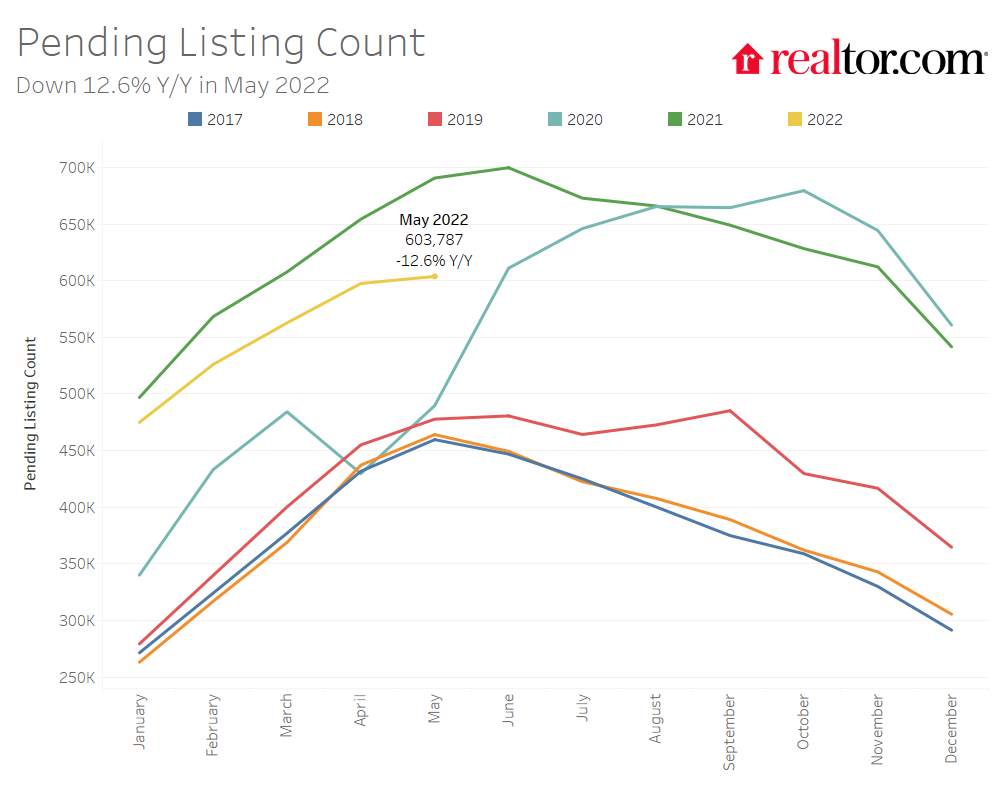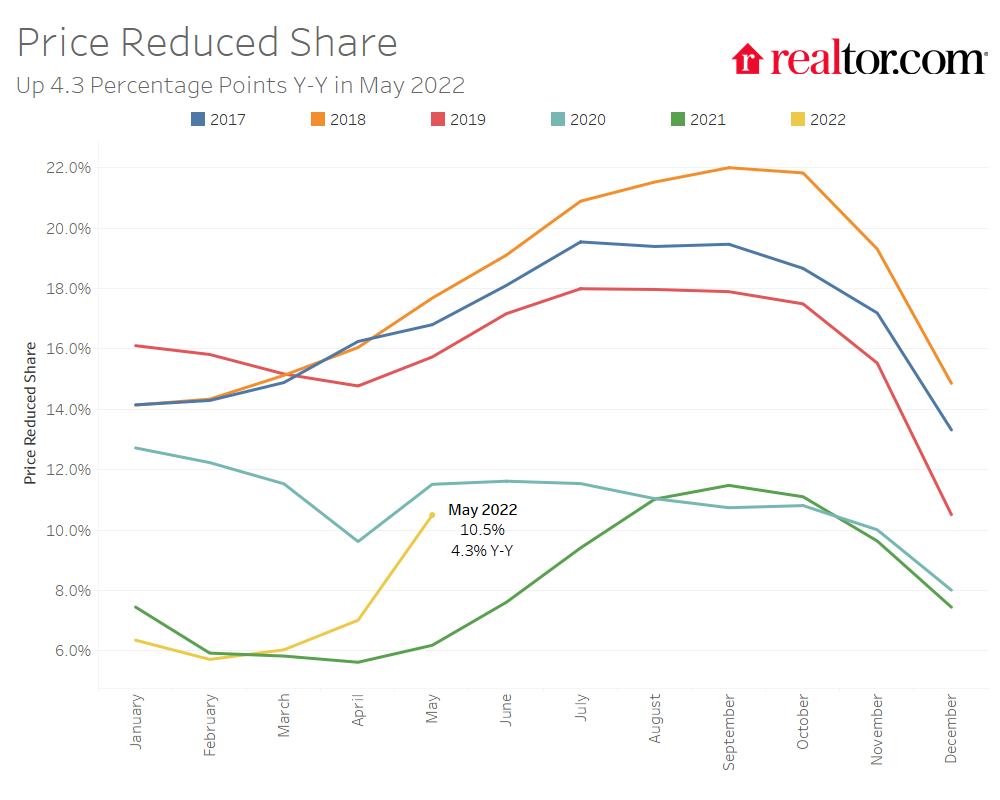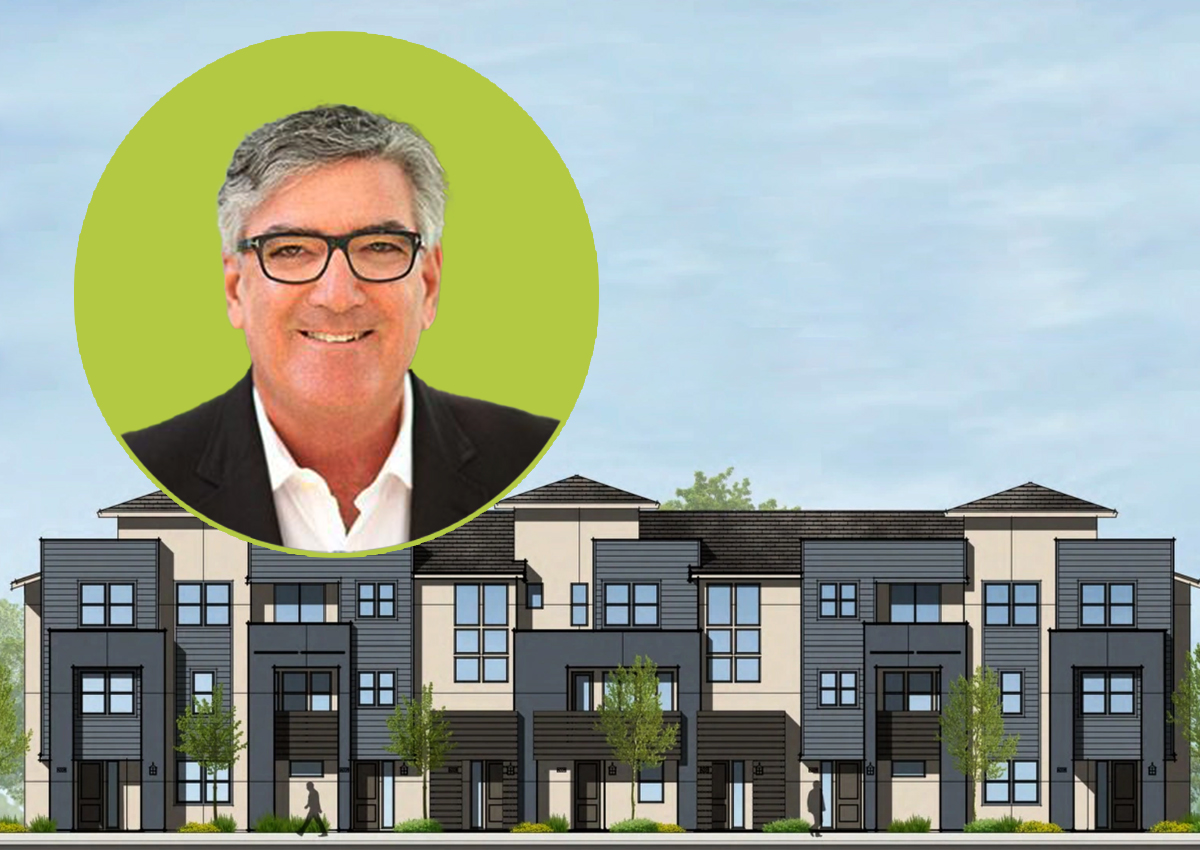May 2022 Housing Market Trends Report
- The inventory of homes for sale has increased for the first time since June 2019.
- The national inventory of active listings increased by 8.0% over last year, while the total inventory of unsold homes, including pending listings, still declined by 3.9% due to a decline in pending inventory.
- The inventory of active listings was down 48.5% compared to May 2020 in the early days of the COVID-19 pandemic. In other words, there are still only half as many homes available.
- More new listings entered the market in May than any other month since June 2019.
- Newly listed homes were up 6.3% nationally compared to a year ago, and up 4.6% for large metros over the past year.
- Sellers still listed at rates 6.4% lower than typical 2017 to 2019 levels prior to the pandemic.
- Housing remains expensive and fast-paced with the median asking price at a new high while time on market is at a new low.
- The May national median listing price for active listings was $447,000, up 17.6% compared to last year and up 35.4% compared to May 2020.
- In large metros, median listing prices grew by 13.0% compared to last year, on average.
- Nationally, the typical home spent 31 days on the market in May, down 6 days from the same time last year and down 40 days from May 2020.
Realtor.com®’s May housing data release reveals a major turning point in inventory, with the count of home listings actively for sale growing compared to last year for the first time since mid-2019. Sellers are fueling this turnaround in inventory, with newly listed homes entering the market at a rate not seen since 2019. However, moderating demand is also playing a role, with pending listings declining compared to last year. Nonetheless, homes are still spending less time on the market compared to last year and prices are still rising, partially driven by an increase in newly listed larger homes and slow adjustments to seller expectations.
Inventory Sees Growth for the First Time Since June 2019
Nationally, the inventory of homes actively for sale on a typical day in May increased by 8.0% over the past year, the first time active inventory has grown since June 2019. This amounted to 38,000 more homes actively for sale on a typical day in May compared to the previous year. The total number of unsold homes nationwide—a metric that includes active listings and listings in various stages of the selling process that are not yet sold—was still down 3.9% percent from May 2021. However this has improved from last month’s 10.1% decline.
The lagged improvement in the total number of homes for sale is due to moderating buyer demand, spurred by rising interest rates and all-time high listing prices that have increased the cost of financing 80% of the typical home by 48% compared to a year ago. The number of pending listings on a typical day (listings that are at various stages of the selling process that are not yet sold), has declined by 12.6% compared to last May, indicating that a moderation in demand is also softening the rate of turnover in inventory. This is a further deceleration from the 8.7% annual decline we reported for April. For homebuyers who are still actively searching for a home, lower competition and more seller activity will provide some relief.

In May, newly listed homes increased above last year’s levels by 6.3%. More newly listed homes entered the market than in any other month since June 2019. However, sellers were still listing at rates 6.4% lower than typical of 2017 to 2019 May levels.

The inventory of homes actively for sale in the 50 largest U.S. metros overall increased by 14.9% over last year in May. In the West, active listings grew most (by +33.6% year-over-year), followed by the South (+18.3%), Midwest (+5.8%), and Northeast (+1.1%). Large western metros saw new listings increase by an average of 7.2% compared to last year and in the south they grew by 6.6%. Northeastern (-1.1% year-over-year) and midwestern (-1.0% year-over-year) large metros were still seeing fewer newly listed homes compared to last year.
Inventory increased in 42 out of 50 of the largest metros compared to last year. Metros which saw the most inventory growth include Austin (+85.8%), Phoenix (+67.1%), and Sacramento (+54.6%). Inventory is still declining on a year-over-year basis in 8 markets, with Miami (-32.1%), Virginia Beach (-19.3%), and Richmond (-15.3%) still seeing the largest declines.
Thirty metros also saw the number of newly listed homes increase compared to last year. The markets which saw the highest year-over-year growth in newly listed homes included southern and western metros such as Raleigh (+27.9%), Nashville (+22.4%) and Las Vegas (+20.7%). Markets which are still seeing a decline in newly listed homes compared to last year include Virginia Beach (-15.1%), Chicago (-10.0%), and Cleveland (-9.3%).
Homes Are Still Selling Quickly
The increase in for-sale home options combined with softening buyer demand would typically drive a deceleration in time on market. However, time on market data did not yet show this trend in May. The typical home spent 31 days on the market in May, which is almost a full week (6 days) less than last year and is the shortest time on record (since 2016). Homes spent 27 fewer days on the market than typical May 2017 to 2019 timing.
In the 50 largest U.S. metros, the typical home spent 26 days on the market, and homes also spent 6 fewer days on the market, on average, compared to May 2021. Among these 50 largest metros, the time a typical property spent on the market decreased most in large metros in the South (-7 days), followed by the West (-6 days), Northeast (-6 days) and Midwest (-4 days).
Among larger metropolitan areas, homes saw the greatest yearly decline in time spent on market in Miami (-28 days), followed by a 3-way tie between Hartford, San Jose, and Seattle (-12 days). Only Detroit saw time on market increase, by just one day, and its time on market is otherwise lower than previous years on record.

Listing Prices Are Still Rising, Newly Listed Homes Are Larger
The median national home price for active listings grew to a new all-time high of $447,000 in May. This represents an annual growth rate of 17.6%, an acceleration from last month’s growth rate of 14.2%. The median listing price for a typical 2,000 square-foot single family home rose 19.3% compared to last year, also an acceleration from 17.3% last month.
Typically, an acceleration in listing prices is a sign of strong demand and/or limited supply. However, given growing supply and softness in sales and pending listings, the median listing price continuing to accelerate compared to last year could also partially be attributed to an increasing share of newly listed larger homes and sellers not yet adjusting to market conditions. The share of newly listed smaller homes (up to 1750 square feet) declined from 47.3% last May to 45.7% this May, while the share of homes larger than 1750 square feet increased from 52.7% to 54.3%. Because of these newly listed homes, larger, more expensive homes make up a bigger share of what’s for-sale this year than last year. In addition, while the median listing price of active listings accelerated, the median list price of listings in pending status–those homes for which the seller has already accepted a buyer’s offer to purchase–actually decelerated, from a year-over-year rate of 17.2% in April to a growth rate of 16.2% in May. This indicates that the homes which buyers are choosing to buy tend to be less expensive, and also suggests that sellers have not fully adjusted their expectations to market conditions.

However, there are signs of this adjustment beginning to occur. The share of homes having their price reduced increased from 6.2% last May to 10.5% this year, but still remains 6.2 percentage points below typical 2017 to 2019 levels. All but one of the largest 50 metros saw an increasing share of price reductions in May, up from 40 last month.

Active listing prices in the nation’s largest metros grew by an average of 13.0% compared to last year. Miami (+45.9%), Nashville (+32.5%), and Orlando (+32.4%), posted the highest year-over-year median list price growth in May. Austin homes showed the greatest growth in the share of homes with price reductions compared to last year (+14.7 percentage points), followed by Las Vegas (+12.3 percentage points) and Phoenix (+11.6 percentage points). Large western metros saw the greatest increase in the share of price reductions (+7.7 percentage points), followed by southern metros (+4.6 percentage points).
May 2022 Regional Statistics (50 Largest Metro Combined Average)
| Region | Active Listing Count YoY | New Listing Count YoY | Median Listing Price YoY | Median Listing Price Per SF YoY | Median Days on Market Y-Y (Days) | Price Reduced Share Y-Y (Percentage Points) |
| Midwest | 5.8% | -1.0% | 6.5% | 8.4% | -4 days | 2.4% |
| Northeast | -1.1% | -1.1% | 6.1% | 8.9% | -6 days | 1.8% |
| South | 18.3% | 8.5% | 18.5% | 17.8% | -7 days | 4.6% |
| West | 33.6% | 7.2% | 14.5% | 12.8% | -6 days | 7.7% |
May 2022 Housing Overview by Top 50 Largest Metros
| Metro | Median Listing Price | Median Listing Price YoY | Median Listing Price per Sq. Ft. YoY | Active Listing Count YoY | New Listing Count YoY | Median Days on Market | Median Days on Market Y-Y (Days) | Price Reduced Share | Price Reduced Share Y-Y (Percentage Points) |
| Atlanta-Sandy Springs-Roswell, Ga. | $428,000 | 9.8% | 13.3% | 10.6% | 2.2% | 29 | -5 | 9.8% | 4.4% |
| Austin-Round Rock, Texas | $627,000 | 25.6% | 23.4% | 85.8% | 19.1% | 16 | -10 | 18.3% | 14.7% |
| Baltimore-Columbia-Towson, Md. | $352,000 | 0.7% | 5.5% | 2.3% | -7.3% | 31 | -3 | 10.1% | 2.5% |
| Birmingham-Hoover, Ala. | $288,000 | 3.2% | 10.2% | 12.5% | 3.5% | 35 | -5 | 8.4% | 3.5% |
| Boston-Cambridge-Newton, Mass.-N.H. | $772,000 | 10.3% | 3.9% | -6.9% | -2.2% | 16 | -7 | 10.0% | 0.9% |
| Buffalo-Cheektowaga-Niagara Falls, N.Y. | $247,000 | -1.2% | 5.9% | 6.6% | 1.0% | 24 | -8 | 5.7% | 1.4% |
| Charlotte-Concord-Gastonia, N.C.-S.C. | $435,000 | 11.5% | 16.9% | 21.1% | 17.0% | 23 | -6 | 12.0% | 4.6% |
| Chicago-Naperville-Elgin, Ill.-Ind.-Wis. | $360,000 | 1.4% | 0.5% | -14.8% | -10.0% | 30 | -7 | 8.8% | 1.3% |
| Cincinnati, Ohio-Ky.-Ind. | $330,000 | -9.6% | 2.7% | 2.7% | 5.0% | 29 | -5 | 7.3% | 1.6% |
| Cleveland-Elyria, Ohio | $215,000 | -2.3% | 7.0% | -1.2% | -9.3% | 36 | 0 | 8.4% | 2.9% |
| Columbus, Ohio | $340,000 | 13.3% | 15.3% | 7.2% | -4.5% | 14 | 0 | 8.5% | 1.1% |
| Dallas-Fort Worth-Arlington, Texas | $473,000 | 24.5% | 21.9% | 34.4% | 18.0% | 23 | -8 | 9.4% | 4.4% |
| Denver-Aurora-Lakewood, Colo. | $695,000 | 16.0% | 4.7% | 49.6% | 16.5% | 10 | -2 | 11.9% | 7.5% |
| Detroit-Warren-Dearborn, Mich. | $275,000 | -1.8% | 4.4% | 19.8% | 2.1% | 23 | 1 | 12.7% | 4.4% |
| Hartford-West Hartford-East Hartford, Conn. | $363,000 | 17.1% | 22.6% | N/A | -0.9% | 18 | -12 | 5.6% | -1.1% |
| Houston-The Woodlands-Sugar Land, Texas | $399,000 | 10.9% | 12.0% | 4.3% | 4.5% | 35 | -3 | 11.6% | 4.8% |
| Indianapolis-Carmel-Anderson, Ind. | $315,000 | 14.5% | 15.4% | 14.2% | 11.2% | 30 | -8 | 9.9% | 3.0% |
| Jacksonville, Fla. | $439,000 | 26.2% | 26.0% | 22.5% | 8.4% | 30 | -8 | 9.6% | 4.2% |
| Kansas City, Mo.-Kan. | $399,000 | 16.2% | 13.7% | 24.4% | -2.5% | 38 | -2 | 5.9% | 1.8% |
| Las Vegas-Henderson-Paradise, Nev. | $500,000 | 28.2% | 26.2% | 18.6% | 20.7% | 22 | -2 | 20.1% | 12.3% |
| Los Angeles-Long Beach-Anaheim, Calif. | $972,000 | 1.4% | 6.7% | 5.1% | -3.4% | 25 | -9 | 10.5% | 5.3% |
| Louisville/Jefferson County, Ky.-Ind. | $292,000 | 6.4% | 8.7% | 19.1% | -1.3% | 22 | -3 | 11.1% | 4.2% |
| Memphis, Tenn.-Miss.-Ark. | $293,000 | 24.9% | 28.9% | 21.4% | 5.0% | 33 | -5 | 7.4% | 2.6% |
| Miami-Fort Lauderdale-West Palm Beach, Fla. | $627,000 | 45.9% | 27.4% | -32.1% | -0.4% | 37 | -28 | 8.4% | 3.0% |
| Milwaukee-Waukesha-West Allis, Wis. | $364,000 | 15.5% | 9.1% | 0.7% | -5.3% | 30 | -5 | 7.4% | 1.3% |
| Minneapolis-St. Paul-Bloomington, Minn.-Wis. | $422,000 | 17.3% | 10.1% | 2.4% | -0.7% | 28 | -5 | 8.4% | 4.4% |
| Nashville-Davidson–Murfreesboro–Franklin, Tenn. | $550,000 | 32.5% | 19.8% | 38.1% | 22.8% | 14 | -2 | 13.2% | 7.7% |
| New Orleans-Metairie, La. | $349,000 | 2.8% | 0.1% | 8.6% | -2.6% | 39 | -11 | 14.5% | 5.8% |
| New York-Newark-Jersey City, N.Y.-N.J.-Pa. | $720,000 | 10.9% | 24.7% | -0.8% | 0.8% | 43 | -1 | 8.9% | 1.1% |
| Oklahoma City, Okla. | $329,000 | 13.5% | 21.1% | 23.4% | N/A | 30 | -11 | 7.1% | 0.1% |
| Orlando-Kissimmee-Sanford, Fla. | $450,000 | 32.4% | 28.2% | 6.6% | 10.3% | 29 | -9 | 9.1% | 3.8% |
| Philadelphia-Camden-Wilmington, Pa.-N.J.-Del.-Md. | $340,000 | 0.0% | 6.6% | 4.1% | 4.9% | 35 | -3 | 10.4% | 2.8% |
| Phoenix-Mesa-Scottsdale, Ariz. | $550,000 | 22.2% | 21.0% | 67.1% | 13.7% | 23 | -8 | 17.5% | 11.6% |
| Pittsburgh, Pa. | $240,000 | -10.5% | -2.7% | 4.6% | -1.5% | 39 | -5 | 12.2% | 4.2% |
| Portland-Vancouver-Hillsboro, Ore.-Wash. | $598,000 | 8.7% | 11.1% | 19.2% | 3.0% | 26 | -7 | 14.6% | 5.0% |
| Providence-Warwick, R.I.-Mass. | $467,000 | 16.9% | 13.7% | 2.1% | -5.8% | 22 | -8 | 6.7% | 2.7% |
| Raleigh, N.C. | $494,000 | 21.2% | 18.6% | 41.6% | 27.9% | 9 | -11 | 7.8% | 4.2% |
| Richmond, Va. | $380,000 | 8.6% | 12.3% | -15.3% | -7.8% | 33 | -5 | 4.8% | 0.9% |
| Riverside-San Bernardino-Ontario, Calif. | $599,000 | 14.2% | 17.0% | 51.6% | 6.3% | 27 | -4 | 13.9% | 9.2% |
| Rochester, N.Y. | $225,000 | -9.7% | -1.2% | 0.9% | 5.6% | 10 | -1 | 7.9% | 1.7% |
| Sacramento–Roseville–Arden-Arcade, Calif. | $649,000 | 11.0% | 11.7% | 54.6% | 5.6% | 23 | -5 | 17.2% | 11.5% |
| San Antonio-New Braunfels, Texas | $396,000 | 25.9% | 22.4% | 44.1% | 9.5% | 32 | -5 | 11.4% | 6.8% |
| San Diego-Carlsbad, Calif. | $926,000 | 15.9% | 14.4% | 9.8% | -6.9% | 21 | -5 | 11.5% | 7.1% |
| San Francisco-Oakland-Hayward, Calif. | $1,129,000 | 3.8% | 6.6% | 32.5% | 2.5% | 23 | -6 | 9.1% | 4.7% |
| San Jose-Sunnyvale-Santa Clara, Calif. | $1,494,000 | 15.1% | 10.2% | 22.9% | 3.2% | 17 | -12 | 9.9% | 4.6% |
| Seattle-Tacoma-Bellevue, Wash. | $834,000 | 22.6% | 11.3% | 38.8% | 17.9% | 17 | -12 | 9.8% | 6.1% |
| St. Louis, Mo.-Ill. | $277,000 | 6.9% | 7.5% | 4.4% | -2.1% | 37 | -8 | 7.3% | 1.3% |
| Tampa-St. Petersburg-Clearwater, Fla. | $437,000 | 30.6% | 26.9% | 35.5% | 11.2% | 27 | -8 | 11.5% | 5.8% |
| Virginia Beach-Norfolk-Newport News, Va.-N.C. | $359,000 | 12.2% | 12.0% | -19.3% | -15.1% | 19 | -2 | 10.1% | 3.1% |
| Washington-Arlington-Alexandria, DC-Va.-Md.-W. Va. | $588,000 | 15.3% | 4.7% | 1.5% | -5.5% | 27 | -4 | 10.1% | 3.6% |
Note: Oklahoma City new listing count growth and Hartford active listing count growth are not available due to data inconsistencies.
Subscribe to our mailing list to receive updates and notifications on the latest data and research.



